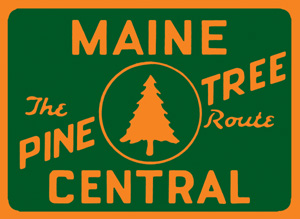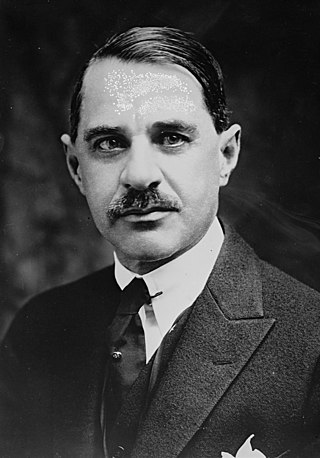
The Rutland Railroad was a railroad in the northeastern United States, located primarily in the state of Vermont but extending into the state of New York at both its northernmost and southernmost ends. After its closure in 1961, parts of the railroad were taken over by the State of Vermont in early 1963 and are now operated by the Vermont Railway.
The Northeast Kingdom is the northeast corner of the U.S. state of Vermont, approximately comprising Essex, Orleans, and Caledonia counties and with a population of 64,764 at the 2010 census. The term "Northeast Kingdom" is attributed to George D. Aiken, former Governor of Vermont and a U.S. senator, who first used the term in a 1949 speech.
The Central Vermont Railway was a railroad that operated in the U.S. states of Connecticut, Massachusetts, New Hampshire, New York, and Vermont, as well as the Canadian province of Quebec.

The Boston and Lowell Railroad was a railroad that operated in Massachusetts in the United States. It was one of the first railroads in North America and the first major one in the state. The line later operated as part of the Boston and Maine Railroad's Southern Division.

The Maine Central Railroad was a U. S. class 1 railroad in central and southern Maine. It was chartered in 1856 and began operations in 1862. By 1884, Maine Central was the longest railroad in New England. Maine Central had expanded to 1,358 miles (2,185 km) when the United States Railroad Administration assumed control in 1917. The main line extended from South Portland, Maine, east to the Canada–United States border with New Brunswick, and a Mountain Division extended west from Portland to St. Johnsbury, Vermont, and north into Quebec. The main line was double track from South Portland to Royal Junction, where it split into a "lower road" through Brunswick and Augusta and a "back road" through Lewiston, which converged at Waterville into single track to Bangor and points east. Branch lines served the industrial center of Rumford, a resort hotel on Moosehead Lake and coastal communities from Bath to Eastport.

The Portland & Ogdensburg Railroad was a railroad planned to connect Portland, Maine to Ogdensburg, New York. The plan failed, and in 1880 the Vermont section was reorganized and leased by the Boston & Lowell Railroad. In 1886, the Maine and New Hampshire section was reorganized as the Portland & Ogdensburg Railway. That part was leased to the Maine Central Railroad in 1888, and in 1912 the Maine Central leased the eastern part of the Vermont section from the Boston & Maine Railroad, the successor to the B&L.

Vermont Route 15 (VT 15) is a 68.957-mile-long (110.976 km) east–west state highway in northern Vermont, United States. Its western terminus is at U.S. Route 2 (US 2) and US 7 in Winooski and its eastern terminus is at US 2 in Danville. It is known as the Grand Army of the Republic Highway, a designation shared nationally with U.S. Route 6.

Randolph station is an Amtrak train station in Randolph, Vermont, United States. The only train that serves the station is the Vermonter, which operates between St. Albans, Vermont and Washington, D.C. The former depot building contains a market and restaurant. On the other side of the tracks is the depot for a non-profit bus company, Tri-Valley Transit, essentially creating an unofficial intermodal transportation center. However, the schedules of the two systems are not aligned in any way.

Rouses Point station is an Amtrak intercity train station in Rouses Point, New York, served by the single daily round trip of the Adirondack. The station building is a former Delaware and Hudson Railway constructed in 1889, with a one low-level side platform on the east side of the track. It was added to the National Register of Historic Places in 2005 as Rouses Point Railroad Station.

Frederick Gleed Fleetwood was an American lawyer and politician from Vermont. He was most notable for his service as Secretary of State of Vermont and a U.S. Representative (1923–1925).
The Ogdensburg and Lake Champlain Railroad was founded in 1849 as the Northern Railroad running from Ogdensburg to Rouses Point, New York. The 118-mile (190 km) railroad was leased by rival Central Vermont Railroad for several decades, ending in 1896. It was purchased in 1901 by the Rutland Railroad and became its Ogdensburg Division.
The St. Johnsbury and Lamoille County Railroad (StJ&LC) was a railroad located in northern Vermont. It provided service to rural parts of the state for over a century, until track deterioration and flood damage made the line unusable and uneconomical to repair, which forced the line to close in 1995. Vermont is in the process of converting the roughly 96-mile route from St. Johnsbury to Swanton into a rail trail, known as the Lamoille Valley Rail Trail. Once completed it will be the longest rail trail in New England.

The Mountain Division is a railroad line that was once owned and operated by the Maine Central Railroad (MEC). It stretches from Portland, Maine on the Atlantic Ocean, through the Western Maine Mountains and White Mountains of New Hampshire, ending at St. Johnsbury, Vermont in the Northeast Kingdom. The line was abandoned in 1983 by MEC's successor, Guilford Transportation Industries (GTI). Guilford retained a stub between Portland and Westbrook. A section in New Hampshire remains in use by heritage railway Conway Scenic Railroad.

The Sandown Depot is a former railroad station of the Boston and Maine Railroad in Sandown, New Hampshire. Built in 1873–74, it is the best-preserved of stations built by the Nashua and Rochester Railroad to survive, remaining relatively unaltered since its construction, and still at its original location. It is now a local history museum, and was listed on the National Register of Historic Places in 1986, and the New Hampshire State Register of Historic Places in 2011.

The Johnson Railroad Depot was a historic former railroad station on Railroad Street in Johnson, Vermont. Built in 1887, it was an excellent example of Victorian railroad architecture, serving as a gateway for the town's industrial products to markets nationwide. Converted to commercial use after rail service was discontinued on the line, it was listed on the National Register of Historic Places in 1980. It has since been demolished; a modern building stands where it used to.

The Morrisville Historic District encompasses most of the historic commercial downtown area of the village of Morrisville in Morristown, Vermont. Developed in the early 19th century as a service town for the surrounding agricultural areas, it was transformed into a major service regional commercial center by the arrive of the railroad in 1872. Its surviving architecture is largely reflective of these two time periods. It was listed on the National Register of Historic Places in 1983, and enlarged in 2007.

The Greensboro Depot is a historic railroad station on Main Street in the village of Greensboro Bend, Vermont. Built about 1872 by the Portland and Ogdensburg Railroad, it is a well-preserved example of that railroad's early station designs, and a reminder of the village's historic association with the railroad. It was listed on the National Register of Historic Places in 1975.
East Hardwick is an unincorporated village in the town of Hardwick, Vermont, United States. It is part of what is known as the Northeast Kingdom (NEK) of Vermont. The community is located on the Lamoille River and along Vermont Route 16, 16 miles (26 km) west-northwest of St. Johnsbury. East Hardwick has a post office with ZIP code 05836, which opened on October 10, 1810. According to a 1937 WPA Federal Writers Project Guidebook, East Hardwick is a "side hill village spilling from the level of a plateau down a sharp incline in the valley of the Lamoille. It is surrounded by rich farm lands, Maple groves and forests."

The Hardwick and Woodbury Railroad was a short-line railroad serving the towns of Hardwick and Woodbury, Vermont. Built to serve the local granite industry by bringing rough stone from the quarries to the cutting-houses, the railroad was about 7 miles (11 km) long, plus leased track, extended to about 11 miles (18 km) at its greatest extent. It connected with only one other railroad, the St. Johnsbury & Lake Champlain, in Hardwick.

















